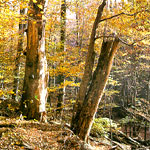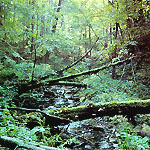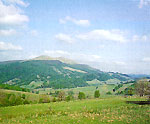 The Slovakian part of the protected area covers mountains lower than the Bieszczady, with very few peaks over 1,000 m above the sea level. The Bukovske Vrchy elevations vary from 198 m to 1,221 m, with the highest peak – Kremenaros – lying at the meeting point of the borders. The only other peaks over 1,000 m are Stinska (1,092 m), and the two tops of Velky Bukovec (1,012 and 1,002 m). This wooded area has a low population density and little agriculture. Wildlife has been affected more in lower areas, but natural features are still preserved in the mountains despite prolonged exploitation of the forests and meadows. The vegetation zones in the
The Slovakian part of the protected area covers mountains lower than the Bieszczady, with very few peaks over 1,000 m above the sea level. The Bukovske Vrchy elevations vary from 198 m to 1,221 m, with the highest peak – Kremenaros – lying at the meeting point of the borders. The only other peaks over 1,000 m are Stinska (1,092 m), and the two tops of Velky Bukovec (1,012 and 1,002 m). This wooded area has a low population density and little agriculture. Wildlife has been affected more in lower areas, but natural features are still preserved in the mountains despite prolonged exploitation of the forests and meadows. The vegetation zones in the
Bukovske Vrchy are similar to those in Bieszczady. The poloniny level is only present on the highest mountains and the slopes are covered by forests of beech Fagus silvaticus, sycamore Acer pseudoplatanus and silver fir Abies alba. Between the forests there are meadows and pastures, which are also present in river valleys. Arable land occurs in the margins of valleys. In the past, these were covered by forests with oak Quercus robur and hornbeam Carpinus betulus, as well as, to a lesser extent, by ash Fraxinus excelsior and alder Alnus glutinosa. Fragments of them are still preserved along with many remnants of the flora typical of the
Carici pilosae-Carpinetum and Mercuriali-Fraxinatum communities. Some of them are preserved in reserves.The best preserved forests are those of the lower forest zone. These are mainly of beech differentiated into 6 vegetation  communities. The most important of these is Carpathian beech forest Dentario glandulosae-Fagetum and the similar sycamore forest Aceri-Fagetum. In lower parts of the mountains, the beech prevails, higher up beech and fir, and still higher – beech and sycamore. The most beautiful beech-fir forest is preserved near Osadny and Nova Sedlica, where firs may be more than 50 metres tall. The timber line of the forests is
communities. The most important of these is Carpathian beech forest Dentario glandulosae-Fagetum and the similar sycamore forest Aceri-Fagetum. In lower parts of the mountains, the beech prevails, higher up beech and fir, and still higher – beech and sycamore. The most beautiful beech-fir forest is preserved near Osadny and Nova Sedlica, where firs may be more than 50 metres tall. The timber line of the forests is
marked by beech, often in dwarfy form. Along mountain streams there are the alder forests Alnetum incanae and Matteucio-Alnetum incanae, and at the foot of the mountains – willow shrubs Agrostio-Salicetum pupureae.
The poloniny zone has mountain meadows and grasslands of which the following have an Eastern-Carpathian character: Poo chaixii-Deschampsietum caespitosae, Poo chaixii-Calamagrostietum arundinacae, Gentiano-Poetum chaixii, Leontodono-Nardetum and Polygalo-Nardetum. Grasses mingle with berry-bearing species in Homogyno-Vaccinetum. The vegetation of the Bukovske Vrchy has a total of c.60 communities of which 15 are forest, 10 meadow and 10 mountain meadow. There are also numerous sedge, herb, xerotermic and other communities.
Throughout the Bukovske Vrchy there are about 960 species of vascular plants, 230 species of moss, 70 liverworts and over 260 fungi. This floristic diversity stems from the variety of conditions, and the transitional location of the area between the Western Carpathians and the massif of the Eastern Carpathians. The flora of  mountain meadows is especially diversified with numerous Eastern Carpathian species, such as Senecio papposus, the spurge Euphorbia sojakii (an endemic species), viper’s grass Scorzonera rosea, the bellflower Campanula abietina and others. Rare East Carpathian forest plants include the vetchling Lathyrus laevigatus, the buttercup Ranunculus carpaticus, the squill Scilla kladnii, and the bastard balm Melittis melissophyllum.
mountain meadows is especially diversified with numerous Eastern Carpathian species, such as Senecio papposus, the spurge Euphorbia sojakii (an endemic species), viper’s grass Scorzonera rosea, the bellflower Campanula abietina and others. Rare East Carpathian forest plants include the vetchling Lathyrus laevigatus, the buttercup Ranunculus carpaticus, the squill Scilla kladnii, and the bastard balm Melittis melissophyllum.
There is a large group of legally-protected species, including the orchids Epipactis helleborine, E. microphylla, Coeloglossum viride, Leucorhis albida, Orchis cariophora, O. ustulata, O. laxiflora elegans, Dactylorhiza sambusina, D. maculata transsilvanica and Traunsteinera globosa, and the gentians Gentiana pneumonathe, G. cruciata, G. lutescens carpatica etc.
The wildlife of this region has many unique species, especially intervebrates. Many species live at the limits of their ranges and others are endemic. Birds include species living in isolated habitats.
Amongst the rarest are the Ural owl, several eagles, and the red and black kites, Milvus milvus and M. migrans. The  poloniny meadows are the home of the water pipit Anthus spinoletta. Among the mammals, the most important larger species of the forest are brown bear, moose Alces alces, deer, and – wandering over from the Bieszczady Mountains – bison. The Bukovske Vrchy are also inhabited by lynxes, as well as by wolves, which are rare. The Aesculapian snake is another rare species. Endemic animals are intervebrates, such as Polydesmus polonicus, Leptoiulus baconyensis stuzicensis, Polyzonium transsilvanicum, Stenus obcuripes and Deltomerus carpaticus. A group of less common East Carpathian intervebrates include the earthworms Allelobophora carpatica and Eisenia lucens, the snail Trichia bielzi, and the insects Strangalia thoracica and Rosalia alpina. Among butterflies, the rare species Apatura iris, Aglia tau, Fabriciana aglaia, Papillo machaon and Parnassius mnemosyne are worthy of note.
poloniny meadows are the home of the water pipit Anthus spinoletta. Among the mammals, the most important larger species of the forest are brown bear, moose Alces alces, deer, and – wandering over from the Bieszczady Mountains – bison. The Bukovske Vrchy are also inhabited by lynxes, as well as by wolves, which are rare. The Aesculapian snake is another rare species. Endemic animals are intervebrates, such as Polydesmus polonicus, Leptoiulus baconyensis stuzicensis, Polyzonium transsilvanicum, Stenus obcuripes and Deltomerus carpaticus. A group of less common East Carpathian intervebrates include the earthworms Allelobophora carpatica and Eisenia lucens, the snail Trichia bielzi, and the insects Strangalia thoracica and Rosalia alpina. Among butterflies, the rare species Apatura iris, Aglia tau, Fabriciana aglaia, Papillo machaon and Parnassius mnemosyne are worthy of note.